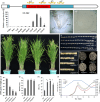NF-YB1-YC12-bHLH144 complex directly activates Wx to regulate grain quality in rice (Oryza sativa L.)
- PMID: 30552799
- PMCID: PMC6576074
- DOI: 10.1111/pbi.13048
NF-YB1-YC12-bHLH144 complex directly activates Wx to regulate grain quality in rice (Oryza sativa L.)
Abstract
Identification of seed development regulatory genes is the key for the genetic improvement in rice grain quality. NF-Ys are the important transcription factors, but their roles in rice grain quality control and the underlying molecular mechanism remain largely unknown. Here, we report the functional characterization a rice NF-Y heterotrimer complex NF-YB1-YC12-bHLH144, which is formed by the binding of NF-YB1 to NF-YC12 and then bHLH144 in a sequential order. Knock-out of each of the complex genes resulted in alteration of grain qualities in all the mutants as well as reduced grain size in crnf-yb1 and crnf-yc12. RNA-seq analysis identified 1496 genes that were commonly regulated by NF-YB1 and NF-YC12, including the key granule-bound starch synthase gene Wx. NF-YC12 and bHLH144 maintain NF-YB1 stability from the degradation mediated by ubiquitin/26S proteasome, while NF-YB1 directly binds to the 'G-box' domain of Wx promoter and activates Wx transcription, hence to regulate rice grain quality. Finally, we revealed a novel grain quality regulatory pathway controlled by NF-YB1-YC12-bHLH144 complex, which has great potential for rice genetic improvement.
Keywords: G-box; Wx gene; grain quality; heterotrimer complex; nuclear factor Y; rice (Oryza sativa L.).
© 2018 The Authors. Plant Biotechnology Journal published by Society for Experimental Biology and The Association of Applied Biologists and John Wiley & Sons Ltd.
Figures






References
-
- Adachi, S. , Yoshikawa, K. , Yamanouchi, U. , Tanabata, T. , Sun, J. , Ookawa, T. , Yamamoto, T. et al. (2017) Fine mapping of carbon assimilation rate 8, a quantitative trait locus for flag leaf nitrogen content, stomatal conductance and photosynthesis in rice. Front. Plant Sci. 8, 60. - PMC - PubMed
-
- Bernadt, C.T. and Rizzino, A. (2003) Roles of the conserved CCAAT and GC boxes of the human and mouse type II transforming growth factor‐β receptor genes. Mol. Reprod. Dev. 65, 353–365. - PubMed
-
- Chen, G. , Wang, Z. , Liu, Q.Q. , Xiong, F. , Yun‐Jie, Gu and Gu, G.‐J. (2006) Development and substance accumulation of caryopsis in transgenic rice with antisense Wx gene. Rice Sci. 13, 106–112. - PubMed
-
- Dai, X. , Ding, Y. , Tan, L. , Fu, Y. , Liu, F. , Zhu, Z. , Sun, X. et al. (2012) LHD1, an allele of DTH8/Ghd8, controls late heading date in common wild rice (Oryza rufipogon). J. Integr. Plant Biol. 54, 790–799. - PubMed
Publication types
MeSH terms
Substances
LinkOut - more resources
Full Text Sources

